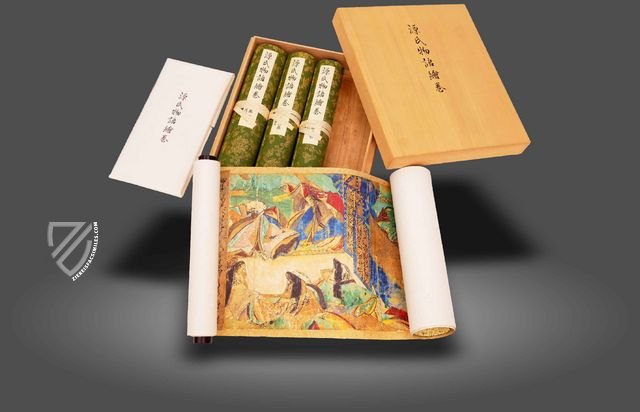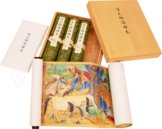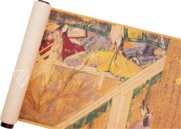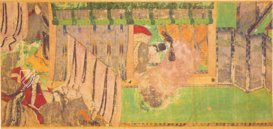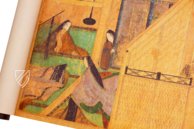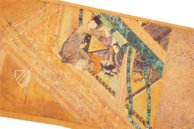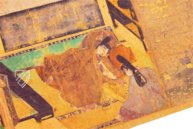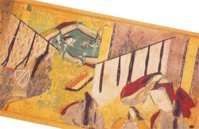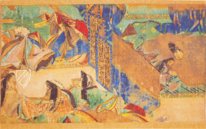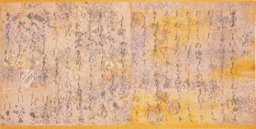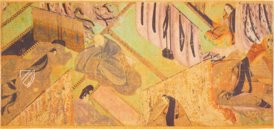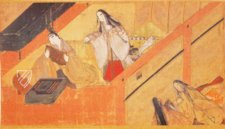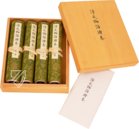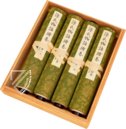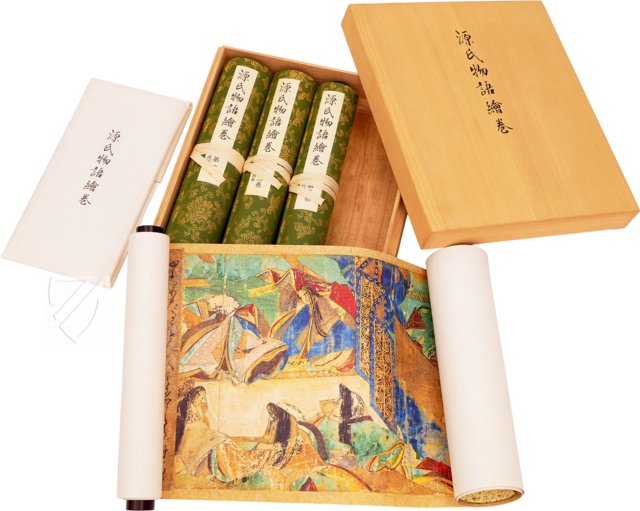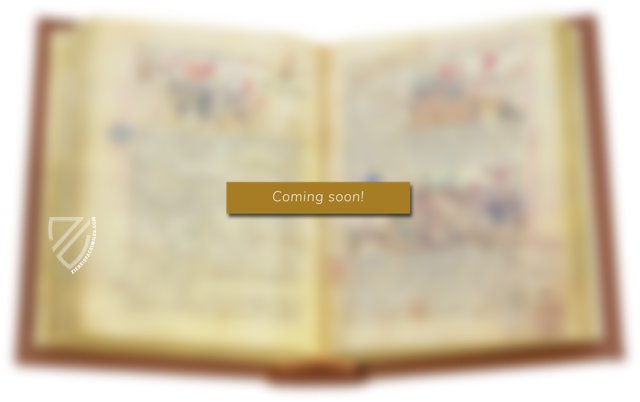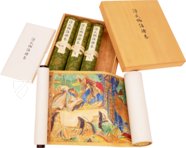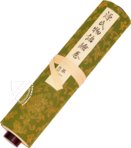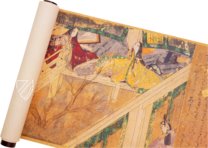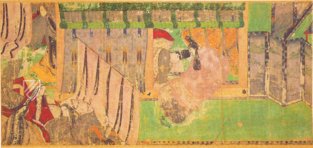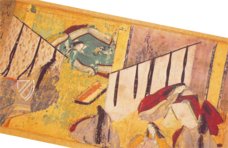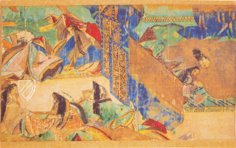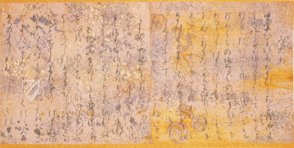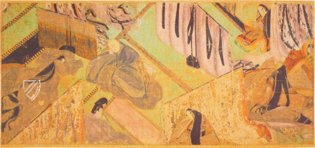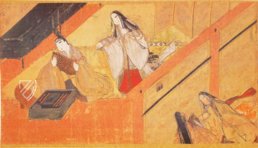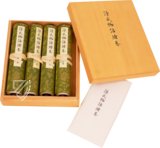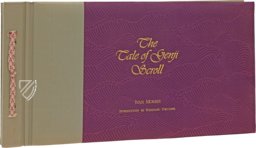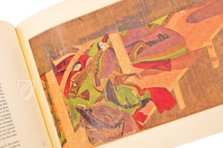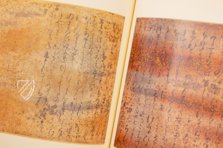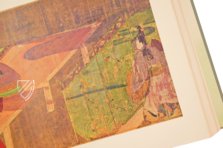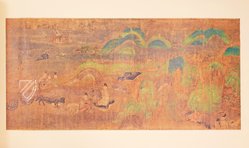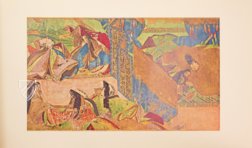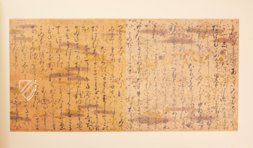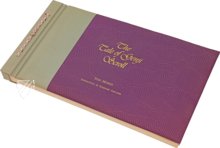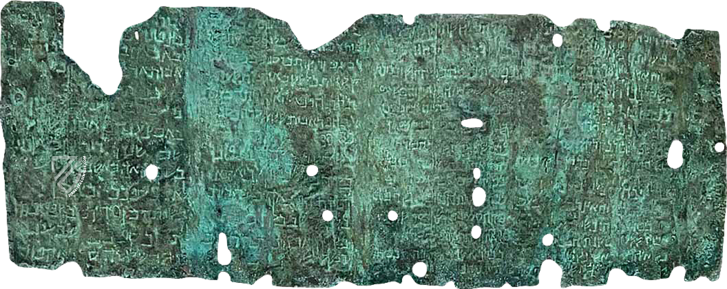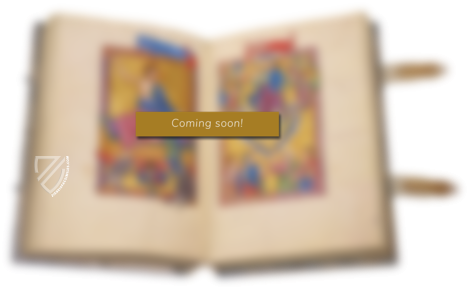Tale of Genji Scroll
(3,000€ - 7,000€)
The Story of Prince Genji is an outstanding work of classical Japanese literature and one of the most important works of world literature. Both the story itself and the pictorial tradition that accompanies the text in Japanese manuscripts have had a lasting influence on art up to the present day. The extensive novel was penned by Murasaki Shikibu (ca. 973/78 – ca. 1014/31), a lady-in-waiting at the imperial palace in Heian-era Japan who was also a writer and poet. Her work provides a unique view of the customs, daily life, and amorous entanglements of the Japanese aristocracy at the imperial palace a thousand years ago. The Genji Monogatari Emaki is an illustrated scroll that transmits the literary text tradition of the Genji monogatari as the oldest surviving copy and for this reason and many more is considered to be a cultural national treasure of Japan. Few manuscripts are likely to have a similar simultaneous significance for both art and literary history.
Tale of Genji Scroll
This classical work of Japanese literature has been called the world’s first novel, the first modern novel, first psychological novel, and the earliest novel to still be considered a classic. The debate about how to classify it aside, the Tale of Genji is a remarkable work, not least of which because of the identity of its author: Murasaki Shikibu (ca. 973/78 – ca. 1014/31), a lady-in-waiting at the imperial court during the Heian Period who was also active as a poet and author. Created at the beginning of the 11th century, it is a highlight of Japan’s Heian period – Heian meaning peace in Japanese – when the country enjoyed great stability and a cultural golden age. The Heian period was also when the Japanese court reached its peak in terms of art, poetry, and literature. Murasaki Shikibu’s work is a depiction of life at the imperial court and concentrates in particular on the customs of the contemporary aristocracy and their romantic entanglements. It recounts the life of Hikaru Genji or “Shining Genji”, so-called because of his supreme handsomeness and intellect. Genji is born the son of the Emperor Kiritsubo and a low-ranking, but beloved concubine. He is removed from the line of succession for political reasons, and so he pursues a career as an imperial officer. The romantic adventures and misadventures of the protagonist are the lens through which this literary masterpiece presents an inside view into life at the Japanese imperial court a millennium ago. This illuminated Genji scroll, known as the Genji Monogatari Emaki is the oldest surviving specimen of the work, whose artistry contrasts realistic, detailed depictions of architecture with unrealistic, typified faces.
A Japanese National Treasure
Unfortunately, the original 11th century manuscript by Murasaki Shikibu no longer exists. The Genji Monogatari Emaki from ca. 1140 is not only a national treasure because it is the oldest Genji manuscript, but also the earliest surviving artwork of the so-called Yamato-e tradition, which is considered to be the classical Japanese style and has continued to influence Japanese art into the present. This manuscript is also the oldest non-Buddhist scroll and the oldest monogatari scroll. Its title consists of the word emaki, stemming from the word Emakimono meaning “picture scrolls”, and monogatari, an extended prose narrative similar to an epic. Artistically speaking, it is purely Japanese and breaks with the Chinese influenced art forms that were common in the time, and is also written in Early Middle Japanese instead of Chinese, which was in vogue among the aristocracy. The scroll contains 19 paintings, 65 sheets of text, and 9 loose pages. It is only a fragment of the original, which must have consisted of 20 scrolls comprising 100 paintings, 300 sheets of calligraphy, and would have been 450-feet-long altogether. It is believed to have originated from a team of female artists, who used the Fukinuki yatai and hikime kagibana techniques to create peaceful, elegant, and static scenes that reflected the tastes of the contemporary Japanese aristocracy. Fukinuki yatai presents events in an interior space from above as though the roof were removed and hikime kagibana depicts faces either from an oblique angle or in profile with essentially identical features, so as to protect the reader’s individual image of the characters.
Codicology
- Type
- Manuscript on paper
- Size / Format
- 4 scrolls / 21.9 × 817.3 cm 21.8 × 535.6 cm 22.1 × 472.0 cm 21.8 × 541.2 cm
- Origin
- Japan
- Date
- Ca. 1120–1140
- Epochs
- Style
- Genre
- Language
- Illustrations
- 19 large illuminations in bright colors
- Content
- Genji Monogatari
- Artist / School
- Murasaki Shikibu (author)
- Previous Owners
- Tokugawa family
Hachisuka family
Tale of Genji Scroll
Secret Observer
In Heian Japan, aristocratic women were strictly forbidden from publicly socializing. They were only allowed to be seen by their fathers, husbands, and other women. The miniatures artfully show how they were shielded from the outside world, and above all, from the male gaze, by a labyrinth of partitions, painted folding screens, and rolled curtains. In this miniature, however, this strategy fails. Genji secretly peeks through an opening in the green bamboo partition into the women's chambers. The motif of peeping runs through the entire work and serves as a precursor to a budding romantic relationship. Murasaki Shikibu's work thus shows that the extensive “security measures” were only a minor obstacle to love in real life as well.
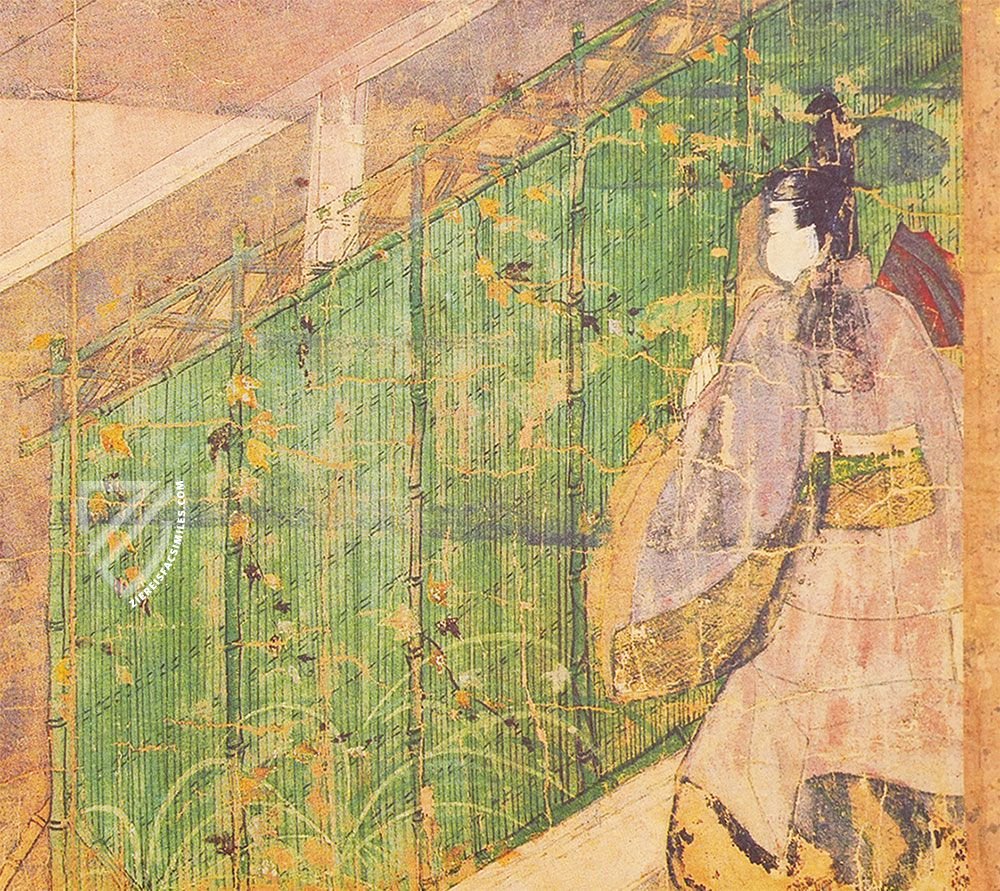
Tale of Genji Scroll
Evening Mist – Murasaki's Final Hours
Warm earth tones dominate this scene, which is filled with a sense of foreboding. It belongs to Chapter 39, which is titled with the poetic and meaningful expression Yūgiri (夕霧) – evening mist. The highly educated court lady Murasaki is the lifelong lover of the protagonist Genji. Although she has just recovered from a serious illness, she now realizes that her life energy is coming to an end.
In preparation for her imminent death, she makes 1,000 copies of the Lotus Sutra, a core doctrine of Buddhism, to be offered up at a grand ceremony. She then gradually bids farewell to her loved ones and dies on a cool autumn morning with a view over her beloved garden.
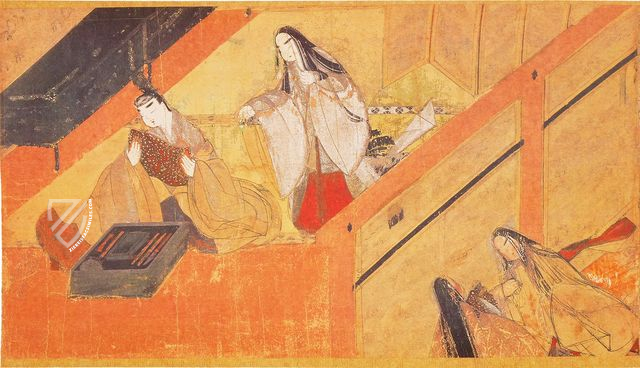
#1 Genji Monogatari Emaki
Language: Japanese
(3,000€ - 7,000€)
#2 Die Geschichte vom Prinzen Genji
(under 1,000€)
#3 Genji Monogatari Emaki
Language: English
The commentary is part of the facsimile volume.
- Treatises / Secular Books
- Apocalypses / Beatus
- Astronomy / Astrology
- Bestiaries
- Bibles / Gospels
- Chronicles / History / Law
- Geography / Maps
- Saints' Lives
- Islam / Oriental
- Judaism / Hebrew
- Single Leaf Collections
- Leonardo da Vinci
- Literature / Poetry
- Liturgical Manuscripts
- Medicine / Botany / Alchemy
- Music
- Mythology / Prophecies
- Psalters
- Other Religious Books
- Games / Hunting
- Private Devotion Books
- Other Genres
- Afghanistan
- Armenia
- Austria
- Belgium
- Belize
- Bosnia and Herzegovina
- China
- Colombia
- Costa Rica
- Croatia
- Cyprus
- Czech Republic
- Denmark
- Egypt
- El Salvador
- Ethiopia
- France
- Germany
- Greece
- Guatemala
- Honduras
- Hungary
- India
- Iran
- Iraq
- Israel
- Italy
- Japan
- Jordan
- Kazakhstan
- Kyrgyzstan
- Lebanon
- Liechtenstein
- Luxembourg
- Mexico
- Morocco
- Netherlands
- Palestine
- Panama
- Peru
- Poland
- Portugal
- Romania
- Russia
- Serbia
- Spain
- Sri Lanka
- Sweden
- Switzerland
- Syria
- Tajikistan
- Turkey
- Turkmenistan
- Ukraine
- United Kingdom
- United States
- Uzbekistan
- Vatican City
- A. Oosthoek, van Holkema & Warendorf
- Aboca Museum
- Ajuntament de Valencia
- Akademie Verlag
- Akademische Druck- u. Verlagsanstalt (ADEVA)
- Aldo Ausilio Editore - Bottega d’Erasmo
- Alecto Historical Editions
- Alkuin Verlag
- Almqvist & Wiksell
- Amilcare Pizzi
- Andreas & Andreas Verlagsbuchhandlung
- Archa 90
- Archiv Verlag
- Archivi Edizioni
- Arnold Verlag
- ARS
- Ars Magna
- ArtCodex
- AyN Ediciones
- Azimuth Editions
- Badenia Verlag
- Bärenreiter-Verlag
- Belser Verlag
- Belser Verlag / WK Wertkontor
- Benziger Verlag
- Bernardinum Wydawnictwo
- BiblioGemma
- Biblioteca Apostolica Vaticana (Vaticanstadt, Vaticanstadt)
- Bibliotheca Palatina Faksimile Verlag
- Bibliotheca Rara
- Boydell & Brewer
- Bramante Edizioni
- Bredius Genootschap
- Brepols Publishers
- British Library
- C. Weckesser
- Caixa Catalunya
- Canesi
- CAPSA, Ars Scriptoria
- Caratzas Brothers, Publishers
- Carus Verlag
- Casamassima Libri
- Centrum Cartographie Verlag GmbH
- Chavane Verlag
- Christian Brandstätter Verlag
- Circulo Cientifico
- Club Bibliófilo Versol
- Club du Livre
- CM Editores
- Collegium Graphicum
- Collezione Apocrifa Da Vinci
- Comissão Nacional para as Comemorações dos Descobrimentos Portugueses
- Coron Verlag
- Corvina
- CTHS
- D. S. Brewer
- Damon
- De Agostini/UTET
- De Nederlandsche Boekhandel
- De Schutter
- Deuschle & Stemmle
- Deutscher Verlag für Kunstwissenschaft
- DIAMM
- Droz
- E. Schreiber Graphische Kunstanstalten
- Ediciones Boreal
- Ediciones Grial
- Ediclube
- Edições Inapa
- Edilan
- Editalia
- Edition Deuschle
- Edition Georg Popp
- Edition Leipzig
- Edition Libri Illustri
- Editiones Reales Sitios S. L.
- Éditions de l'Oiseau Lyre
- Editions Medicina Rara
- Editorial Casariego
- Editorial Mintzoa
- Editrice Antenore
- Editrice Velar
- Edizioni Edison
- Egeria, S.L.
- Eikon Editores
- Electa
- Emery Walker Limited
- Enciclopèdia Catalana
- Eos-Verlag
- Ephesus Publishing
- Ernst Battenberg
- Eugrammia Press
- Extraordinary Editions
- Fackelverlag
- Facsimila Art & Edition
- Facsimile Editions Ltd.
- Facsimilia Art & Edition Ebert KG
- Faksimile Verlag
- Feuermann Verlag
- Folger Shakespeare Library
- Franco Cosimo Panini Editore
- Friedrich Wittig Verlag
- Fundación Hullera Vasco-Leonesa
- G. Braziller
- Gabriele Mazzotta Editore
- Gebr. Mann Verlag
- Gesellschaft für graphische Industrie
- Getty Research Institute
- Giovanni Domenico de Rossi
- Giunti Editore
- Graffiti
- Grafica European Center of Fine Arts
- Guido Pressler
- Guillermo Blazquez
- Gustav Kiepenheuer
- H. N. Abrams
- Harrassowitz
- Harvard University Press
- Helikon
- Hendrickson Publishers
- Henning Oppermann
- Herder Verlag
- Hes & De Graaf Publishers
- Hoepli
- Holbein-Verlag
- Houghton Library
- Hugo Schmidt Verlag
- Idion Verlag
- Il Bulino, edizioni d'arte
- ILte
- Imago
- Insel Verlag
- Insel-Verlag Anton Kippenberger
- Instituto de Estudios Altoaragoneses
- Instituto Nacional de Antropología e Historia
- Introligatornia Budnik Jerzy
- Istituto dell'Enciclopedia Italiana - Treccani
- Istituto Ellenico di Studi Bizantini e Postbizantini
- Istituto Geografico De Agostini
- Istituto Poligrafico e Zecca dello Stato
- Italarte Art Establishments
- Jan Thorbecke Verlag
- Johnson Reprint Corporation
- Josef Stocker
- Josef Stocker-Schmid
- Jugoslavija
- Karl W. Hiersemann
- Kasper Straube
- Kaydeda Ediciones
- Kindler Verlag / Coron Verlag
- Kodansha International Ltd.
- Konrad Kölbl Verlag
- Kurt Wolff Verlag
- La Liberia dello Stato
- La Linea Editrice
- La Meta Editore
- Lambert Schneider
- Landeskreditbank Baden-Württemberg
- Leo S. Olschki
- Les Incunables
- Liber Artis
- Library of Congress
- Libreria Musicale Italiana
- Lichtdruck
- Lito Immagine Editore
- Lumen Artis
- Lund Humphries
- M. Moleiro Editor
- Maison des Sciences de l'homme et de la société de Poitiers
- Manuscriptum
- Martinus Nijhoff
- Maruzen-Yushodo Co. Ltd.
- MASA
- Massada Publishers
- McGraw-Hill
- Metropolitan Museum of Art
- Militos
- Millennium Liber
- Müller & Schindler
- Nahar - Stavit
- Nahar and Steimatzky
- National Library of Wales
- Neri Pozza
- Nova Charta
- Oceanum Verlag
- Odeon
- Orbis Mediaevalis
- Orbis Pictus
- Österreichische Staatsdruckerei
- Oxford University Press
- Pageant Books
- Parzellers Buchverlag
- Patrimonio Ediciones
- Pattloch Verlag
- PIAF
- Pieper Verlag
- Plon-Nourrit et cie
- Poligrafiche Bolis
- Presses Universitaires de Strasbourg
- Prestel Verlag
- Princeton University Press
- Prisma Verlag
- Priuli & Verlucca, editori
- Pro Sport Verlag
- Propyläen Verlag
- Pytheas Books
- Quaternio Verlag Luzern
- Reales Sitios
- Recht-Verlag
- Reichert Verlag
- Reichsdruckerei
- Reprint Verlag
- Riehn & Reusch
- Roberto Vattori Editore
- Rosenkilde and Bagger
- Roxburghe Club
- Salerno Editrice
- Saltellus Press
- Sandoz
- Sarajevo Svjetlost
- Schöck ArtPrint Kft.
- Schulsinger Brothers
- Scolar Press
- Scrinium
- Scripta Maneant
- Scriptorium
- Shazar
- Siloé, arte y bibliofilia
- SISMEL - Edizioni del Galluzzo
- Sociedad Mexicana de Antropología
- Société des Bibliophiles & Iconophiles de Belgique
- Soncin Publishing
- Sorli Ediciones
- Stainer and Bell
- Studer
- Styria Verlag
- Sumptibus Pragopress
- Szegedi Tudomànyegyetem
- Taberna Libraria
- Tarshish Books
- Taschen
- Tempus Libri
- Testimonio Compañía Editorial
- Thames and Hudson
- The Clear Vue Publishing Partnership Limited
- The Facsimile Codex
- The Folio Society
- The Marquess of Normanby
- The Richard III and Yorkist History Trust
- Tip.Le.Co
- TouchArt
- TREC Publishing House
- TRI Publishing Co.
- Trident Editore
- Tuliba Collection
- Typis Regiae Officinae Polygraphicae
- Union Verlag Berlin
- Universidad de Granada
- University of California Press
- University of Chicago Press
- Urs Graf
- Vallecchi
- Van Wijnen
- VCH, Acta Humaniora
- VDI Verlag
- VEB Deutscher Verlag für Musik
- Verlag Anton Pustet / Andreas Verlag
- Verlag Bibliophile Drucke Josef Stocker
- Verlag der Münchner Drucke
- Verlag für Regionalgeschichte
- Verlag Styria
- Vicent Garcia Editores
- W. Turnowski Ltd.
- W. Turnowsky
- Waanders Printers
- Wiener Mechitharisten-Congregation (Wien, Österreich)
- Wissenschaftliche Buchgesellschaft
- Wissenschaftliche Verlagsgesellschaft
- Wydawnictwo Dolnoslaskie
- Xuntanza Editorial
- Zakład Narodowy
- Zollikofer AG

